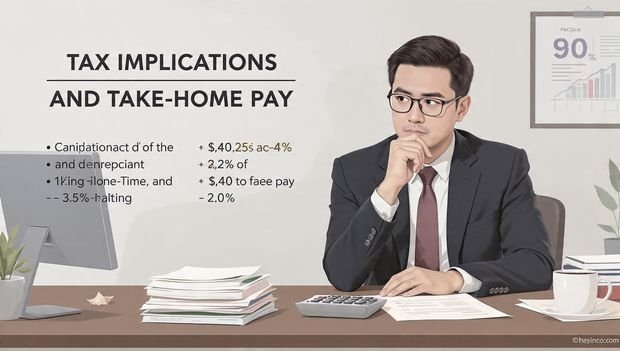Freelancing vs Full-Time Job: Which One Pays More in 2025?
Compare freelancing vs full-time job salaries in 2025. Discover earning potential, income stability, benefits, and which career path pays more.

The debate between freelancing vs full-time job opportunities has intensified dramatically in 2025, as more professionals question traditional career paths and explore alternative ways to earn a living. With the freelance market projected to reach $8.39 billion this year and the gig economy growing 15 times faster than traditional employment, which career path offers superior financial rewards has become a critical decision for millions of workers worldwide. The question of which pays more is no longer straightforward, as the answer depends on numerous factors, including industry, experience level, geographical location, skill specialization, and personal work preferences.
Recent statistics reveal fascinating insights into freelance income patterns. Freelancers in the United States earn an average of $47.71 per hour, with annual earnings averaging $99,230, while 60% of freelancers who left full-time jobs to become freelancers report making more money than they did in their previous positions. However, 55% of freelancers earn under $50,000 per year, highlighting the significant income variability inherent in independent work. Meanwhile, full-time employees enjoy consistent paychecks, comprehensive benefits packages including health insurance and retirement plans, and structured career advancement opportunities, though their earning potential may plateau based on predetermined salary ranges and annual raise schedules.
The financial comparison between freelancing and traditional employment extends beyond simple salary numbers. Freelancers typically need to charge 1.4 to 2.08 times the equivalent full-time hourly rate to account for business expenses, self-employment taxes, healthcare costs, retirement savings, and unpaid vacation time. This multiplier ensures freelancers maintain comparable take-home pay after covering expenses that employers traditionally fund for full-time staff. These hidden costs and true compensation structures are essential for making informed career decisions.
In 2025, the landscape of work continues evolving rapidly, with remote work normalization, artificial intelligence adoption, and shifting employer-employee dynamics reshaping both freelance and traditional employment markets. Millennials and Gen Z workers particularly embrace freelancing, with 48% of Gen Z workers currently freelancing and 67% either freelancing or planning to start, driven by desires for flexibility, autonomy, and skepticism about traditional career paths. Meanwhile, economic uncertainties, inflation concerns, and the rising cost of living make financial security increasingly important, regardless of employment structure.
This comprehensive analysis examines freelancing versus full-time employment from multiple financial perspectives, exploring actual earning potential, total compensation including benefits, income stability considerations, tax implications, long-term wealth building opportunities, and industry-specific variations. Whether you’re contemplating leaving a corporate position to pursue independent work, considering returning to traditional employment after freelancing, or simply curious about maximizing your earning potential, this guide provides the data-driven insights needed to make the right choice for your financial future and career aspirations.
Freelance Income in 2025
Freelance earnings in 2025 present a complex picture characterized by substantial earning potential alongside significant income variability, making it essential to understand the full spectrum of financial realities facing independent workers.
Average Freelance Earnings and Hourly Rates
The financial landscape for freelancers varies dramatically based on specialization, experience, and market demand. On average, freelancers earn $99,230 annually, with hourly wages ranging from $14.90 to $132.21. However, these broad averages mask significant disparities across different fields and skill levels. Most freelancers earn between $24.28 (25th percentile) and $61.78 (75th percentile) per hour, representing a wide earnings range depending on expertise and specialization.
Skilled service providers command premium rates in today’s market. Programmers earn the highest average pay at $60-$70 per hour, translating to approximately $120,000 annually, while data analysts and mobile developers make $55-$65 per hour with annual earnings around $100,000. Writers and editors typically earn more modest rates, with freelance writers earning between $30-40 per hour with an early income of around $42,000, though exceptional copywriters can command up to $250 per hour for specialized work.
Geographic location significantly impacts freelance income potential. German freelancers in tech and data earn an average of €735 per day, compared to €492 in France and €230 in Spain, demonstrating how market conditions and cost of living influence rates. Within the United States, freelancers in major metropolitan areas typically command higher rates than those in smaller markets, though remote work capabilities increasingly enable location-independent pricing.
Income Variability and Consistency Challenges
One of the most significant differences between freelancing and full-time employment involves income predictability. Unlike salaried positions offering guaranteed monthly payments, freelance income fluctuates based on project availability, client payment practices, seasonal business cycles, and economic conditions. 50% of freelancers have experienced late or missed payments from employers, creating cash flow challenges that can disrupt financial planning and stability.
The feast-or-famine cycle represents a common challenge for independent workers. Some months bring abundant projects and substantial earnings, while others may see minimal work and correspondingly low income. This unpredictability makes budgeting difficult and requires maintaining substantial emergency reserves to cover lean periods. Many freelancers report that building consistent, reliable income streams takes considerable time, often requiring 12-18 months or longer to establish stable client relationships and predictable project flow.
Income distribution among freelancers reveals significant inequality. Top earners achieve annual earnings of $200,000, while 25% of freelancers earn just $50,500 annually. This disparity reflects differences in skill levels, marketing effectiveness, niche specialization, experience, and ability to secure high-value clients. Success in freelancing requires not just technical skills but also business acumen, client relationship management, effective self-promotion, and consistent quality delivery.
Factors Influencing Freelance Earning Potential
Multiple factors determine an individual’s freelance earning capacity beyond basic skill competency. Experience level significantly impacts rates, with seasoned professionals commanding premium fees while newcomers often accept lower rates to build portfolios and establish reputations. Before taking up freelancing, independent workers spend on average 12 years gaining experience, suggesting that successful freelancing often builds upon substantial traditional employment experience.
Education and certifications enhance earning potential, particularly in technical fields where specific credentials demonstrate expertise and proficiency. Portfolio quality and client testimonials serve as social proof, enabling freelancers to justify higher rates based on demonstrated results and satisfied customer recommendations. Niche specialization often generates premium pricing, as experts in narrow fields face less competition and serve clients with specific, valuable needs.
Market demand fluctuates based on economic conditions, technological trends, and industry-specific factors. Fields experiencing skills shortages enable freelancers to command premium rates, while oversaturated markets create pricing pressure. The rise of artificial intelligence and automation affects different freelance categories differently, eliminating some opportunities while creating new ones requiring human creativity, strategic thinking, and emotional intelligence.
Full-Time Employment Compensation in 2025

Full-time job salaries in 2025 offer predictable income structures alongside comprehensive benefits packages, though earning growth may follow more constrained trajectories compared to successful freelancing.
Average Salaries for Full-Time Employees
Full-time employment provides consistent, predictable income through regular paychecks deposited at predetermined intervals. IT professionals in the United States make, on average $89,800 per year according to salary estimates, representing typical earning potential for skilled professionals in traditional employment arrangements. However, salary levels vary tremendously based on industry, company size, geographic location, role seniority, and individual negotiation outcomes.
Entry-level positions typically offer modest starting salaries with potential for growth through promotions and annual raises. Mid-career professionals benefit from accumulated experience and proven track records, often earning substantially more than early-career workers. Senior roles and executive positions command premium compensation, frequently including significant bonuses, stock options, and other performance-based incentives beyond base salary.
Salary progression in traditional employment generally follows structured pathways tied to tenure, performance evaluations, promotions, and company policies. Annual raises typically range from 2-5% for satisfactory performance, with larger increases accompanying promotions or exceptional contributions. However, this structured approach also creates earning ceilings, where professionals reach maximum salary ranges for their positions and must change roles or companies to achieve significant income increases.
Comprehensive Benefits Beyond Base Salary
The true value of full-time employment extends substantially beyond base salary through employer-provided benefits that represent significant additional compensation. Health insurance coverage alone provides tremendous value, with employer-sponsored plans typically costing $7,800 annually for individual coverage and substantially more for family plans. Employees usually pay only a fraction of these costs through payroll deductions, with employers covering the majority of premiums.
- Retirement benefits include employer matching contributions to 401(k) or similar plans, effectively providing free money that compounds over decades. Many companies match 50-100% of employee contributions up to 3-6% of salary, representing thousands of dollars in annual additional compensation. Pension plans, while less common than historically, still exist in some sectors and provide guaranteed retirement income.
- Paid time off represents significant hidden compensation. Assuming 3 weeks of paid vacation and 5 paid sick days per year equals 7.7% of the full work year, meaning at an annual salary of $150,000, that’s $11,550 going to vacation and sick time. Freelancers receive zero pay for time off, requiring them to account for unpaid vacation periods when calculating true hourly rates and annual earnings requirements.
Additional perks vary by employer but may include life insurance, disability coverage, professional development budgets, tuition reimbursement, employee stock purchase plans, gym memberships, commuter benefits, parental leave, and various other programs adding thousands to tens of thousands of dollars in annual value. When calculating true total compensation, these benefits often add 30-50% or more to base salary value.
Job Security and Income Stability
Employment stability represents a primary advantage of traditional jobs. Barring performance issues, layoffs, or company failures, full-time employees enjoy reasonable confidence in continued employment and income. This predictability enables confident financial planning, major purchase decisions, mortgage qualifications, and long-term commitments difficult for freelancers with variable income.
However, job security has eroded compared to previous generations. Layoffs, restructurings, acquisitions, and economic downturns create termination risks even for strong performers. The rise of at-will employment means most workers can be dismissed with minimal notice, though severance packages sometimes provide financial cushions. Severance can range from weeks to more than a year of pay for employees after they depart, depending on tenure, title, and negotiated agreements.
Career advancement opportunities in traditional employment follow defined pathways, with clear progression from junior to senior roles, management tracks, and increasing responsibility levels. Companies invest in employee development through training, mentoring, and skill-building opportunities that accelerate professional growth. However, advancement depends on organizational needs, available positions, performance evaluations, and sometimes office politics or favoritism rather than purely merit-based assessment.
Direct Financial Comparison: Freelance vs Full-Time
When comparing freelancing versus full-time employment financially, simple salary comparisons prove insufficient—comprehensive analysis must account for all costs, benefits, taxes, and financial obligations unique to each arrangement.
Calculating True Hourly Rate Equivalencies
True earning equivalencies between freelance and full-time work require adjusting for fundamental structural differences. Freelancers typically need to charge 1.4 to 2.08 times the equivalent full-time hourly rate to achieve a comparable take-home income after accounting for additional expenses. This multiplier covers several categories of costs that full-time employers provide, but freelancers must fund independently.
To calculate equivalent hourly rates, start with a full-time annual salary and divide by 2,080 hours (52 weeks × 40 hours). A $100,000 salary equals approximately $48 per hour. A freelancer would need to charge $67-$100 per hour ($48 × 1.4-2.08) to achieve a comparable net income after covering business expenses, healthcare, retirement contributions, self-employment taxes, and accounting for unpaid time off.
This calculation reveals why freelancers earning $47.71 per hour average $99,230 annually despite working comparable hours to full-time employees. Higher hourly rates compensate for structural cost differences and income inconsistency inherent in project-based work. Skilled freelancers commanding $70-$100+ per hour may significantly out-earn full-time counterparts, while those charging lower rates may struggle to match traditional employment compensation.
Hidden Costs of Freelancing
Freelance business expenses significantly reduce gross income, requiring careful financial management to maintain profitability. Self-employment taxes add approximately 15.3% for Social Security and Medicare contributions, compared to employees who split these costs with employers. Freelancers also pay both halves themselves, substantially increasing tax obligations compared to traditional employment at similar income levels.
Healthcare coverage represents one of the largest expenses for independent workers. Health insurance isn’t readily available to approximately 29 million freelancers, and those purchasing individual market insurance pay significantly more than employer-sponsored plan costs. Premium monthly costs of $400-$800 for individual coverage translate to $4,800-$9,600 annually, substantially reducing take-home income.
Office expenses, including workspace rental, equipment purchases, software subscriptions, internet service, phone costs, professional liability insurance, accounting services, and marketing expenditures, add thousands of dollars annually. Office space averages between $300-$1,230 per month per employee, spending anywhere from $3,600 to $14,760 annually on workspace alone. Remote freelancers avoid some costs but still require e dedicated workspace, technology infrastructure, and professional equipment.
Retirement savings fall entirely on freelancers without employer matching contributions or automatic payroll deductions. Self-employed individuals must proactively set aside retirement funds, typically aiming for 15-20% of income but often saving less due to cash flow challenges. The lack of employer matching eliminates significant free money that compounds dramatically over career spans.
Additional Costs for Full-Time Employees
While full-time jobs provide numerous benefits, they also impose costs that freelancers avoid. Commuting expenses, including vehicle depreciation, gasoline, parking, tolls, or public transportation fares, add thousands annually. The average American commuter spends 30-60 minutes each direction daily, representing 250-500 hours annually of unpaid, unproductive time with associated costs.
Professional wardrobe requirements mandate maintaining appropriate business attire, dry cleaning services, and regular clothing replacement, which freelancers working from home largely avoid. Workplace meals, coffee purchases, and social obligations create additional recurring expenses. Some estimate these combined costs at $5,000-$15,000 annually, depending on location and industry norms.
Opportunity costs of traditional employment include limited flexibility for side projects, restrictions on outside work due to non-compete agreements or conflicts of interest, and constraints on pursuing passion projects or additional income streams. Full-time employees trade autonomy and flexibility for stability and benefits, a calculation that favors different individuals based on personal priorities and life circumstances.
Income Potential and Earning Trajectories
Long-term earning potential differs substantially between freelancing and traditional employment, with each path offering distinct advantages depending on skills, ambition, and market positioning.
Freelance Income Growth Opportunities
Successful freelancers enjoy essentially unlimited earning potential constrained only by available working hours, market rates they can command, and the ability to secure high-value clients. Unlike salaried positions with defined compensation ranges, freelance rates can increase dramatically as reputation grows, expertise deepens, and client base expands. 93% of full-time freelancers say they have the flexibility to determine their income, and freelancing offers the possibility to earn more money when they choose.
Rate increases occur organically as freelancers gain experience, build portfolios demonstrating results, accumulate positive testimonials, and develop specialized expertise commanding premium pricing. Skilled professionals can double or triple rates over 3-5 years as they transition from generalist work to high-value specialization. Some freelancers scale beyond individual contributor models by building agencies, hiring subcontractors, or creating productized services that generate revenue without direct time investment.
However, income growth requires deliberate effort, including continuous skill development, strategic marketing, network cultivation, and consistent delivery excellence that generates referrals and repeat business. 67% of full-time freelancers expect their income to rise in the next year, reflecting optimism about growth opportunities, though actual results depend heavily on market conditions and individual performance.
Full-Time Career Advancement and Salary Growth
Traditional employment offers structured advancement through clearly defined career ladders with predictable salary increases accompanying promotions. Entry-level professionals earning $50,000-$70,000 may reach $80,000-$120,000 as mid-level contributors, and $150,000-$250,000+ in senior or management roles over 15-20 year careers. Total compensation, including bonuses, equity, and benefits, can reach much higher levels in lucrative industries like technology, finance, or consulting.
However, career progression depends on organizational needs, available positions, company performance, and competition with colleagues for limited advancement opportunities. Many professionals hit earning plateaus where further increases require changing employers or transitioning to more senior roles that may not align with their interests or strengths. Geographic limitations also constrain opportunities, as advancing careers sometimes requires relocating to company headquarters or major market hubs.
Salary negotiations occur primarily during hiring or promotion discussions rather than continuously like freelance rate adjustments. This creates periodic opportunities for significant increases but also long periods of predictable, modest annual raises. Many employees feel constrained by internal equity considerations and predetermined salary bands that limit earning potential regardless of individual contribution or market value.
The Hybrid Approach: Maximum Earning Potential
Many professionals discover that combining freelancing and full-time employment either simultaneously or sequentially maximizes lifetime earning potential. Working a full-time job while building a freelance practice evenings and weekends provides income security while testing market demand, developing skills, and establishing client relationships with limited risk.
This hybrid model enables learning business operations, client management, and project delivery while maintaining health insurance, retirement contributions, and a stable base income. Once freelance earnings reach sufficient levels and demonstrate sustainability, transitioning to full-time independent work becomes less risky with established momentum and proven income potential.
Alternatively, experienced freelancers sometimes return to traditional employment for periods of career development, skill acquisition, benefits access, or financial stability during major life events like starting families or recovering from health issues. This flexible career approach treats employment status as a strategic choice optimized for current circumstances rather than permanent entity commitment.
Tax Implications and Take-Home Pay

Tax differences between freelancing and traditional employment significantly impact net income calculations and actual financial outcomes despite similar gross earnings.
Tax Obligations for Freelancers
- Self-employed individuals face more complex tax situations with greater obligations, but also more deduction opportunities. Self-employment tax adds 15.3% covering both employee and employer portions of Social Security and Medicare contributions, applied to net business income. This substantially increases tax burden compared to W-2 employees who split these costs with employers, though freelancers can deduct the employer-equivalent portion (7.65%) from income taxes.
- Quarterly estimated tax payments require freelancers to calculate and remit federal and state taxes four times annually rather than having them automatically withheld from paychecks. Missing or underpaying estimates triggers penalties and interest charges, while overpaying creates cash flow challenges. Many freelancers struggle initially with tax compliance, sometimes facing unexpectedly large bills during their first tax season when they haven’t set aside sufficient funds.
However, business expense deductions provide significant tax advantages. Freelancers can write off business expenses, including coworking space memberships, new laptops, software, productivity tools, and transport costs, deducting these from taxable income annually. Home office deductions, equipment purchases, professional development, marketing expenses, insurance premiums, and retirement contributions all reduce taxable income, sometimes substantially lowering effective tax rates compared to employees with limited deduction opportunities.
Tax Advantages and Simplicity for Full-Time Employees
W-2 employees enjoy significant tax simplification through automaticwithholdingng where employers calculate and remit taxes from each paycheck. This eliminates quarterly payment requirements, reduces compliance burden, and ensures steady tax payments throughout the year rather than lump-sum obligations. Most employees simply file annual returns claiming standard or itemized deductions without complex business accounting.
Employer-provided benefits carry substantial tax advantages. Health insurance premiums, retirement contributions up to annual limits, flexible spending account contributions, and various other benefits reduce taxable income while providing valuable services. These pre-tax benefits effectively lower tax rates while increasing total compensation value.
However, W-2 workers have limited deduction opportunities beyond mortgage interest, charitable contributions, and state/local taxes, with the 2017 Tax Cuts and Jobs Act eliminating unreimbursed employee expense deductions for most workers. This limits tax optimization strategies compared to self-employed individuals who can structure businesses to maximize legitimate deductions within legal boundaries.
Quality of Life and Non-Financial Considerations
While this analysis focuses primarily on financial comparisons, quality of life factors significantly influence career satisfaction and long-term success, indirectly affecting earning potential through motivation, productivity, and career longevity.
Flexibility and Work-Life Balance
Freelancers enjoy tremendous schedule flexibility, working when and where they choose, subject to client deadlines and commitments. This enables optimizing productivity around personal energy patterns, attending to family needs, pursuing hobbies, and integrating work with life rather than separating them rigidly. 84% of full-time freelancers are happy with their current roles, valuing control over work-life balance and the nd ability to choose projects.
However, flexibility can become a double-edged sword. Without structured schedules, some freelancers struggle with self-discipline, procrastination, or overwork without clear boundaries between professional and personal time. Client deadlines may require evening or weekend work, and the pressure to maximize earnings during busy periods can lead to burnout and health issues.
Full-time employees operate within defined schedules, providing structure and routine that some individuals find helpful for productivity and work-life separation. However, this structure also creates rigidity, limiting the ability to attend daytime appointments, pursue personal interests during traditional business hours, or adjust schedules around family needs without using limited paid time off or navigating approval processes.
Job Satisfaction and Professional Fulfillment
68% of freelancers say their quality of life has improved since they began freelancing, with another 23% reporting it stayed the same, suggesting independent work enhances life satisfaction for most practitioners. The ability to choose projects, select clients, specialize in interesting work, and control work environment contributes to professional fulfillment and intrinsic motivation.
Traditional employment provides clear career progression, collaborative team environments, mentorship opportunities, and organizational resources that many professionals value. Working alongside colleagues, participating in large-scale projects, and contributing to organizational missions creates meaning and connection difficult to replicate in solo freelance work. Some tasks require brainstorming and team collaboration that aren’t offered by freelancing jobs, potentially limiting creative development and professional growth.
More Read: Top 10 Freelancing Platforms for Beginners in 2025
Conclusion
The question of whether freelancing or full-time employment pays more in 2025 defies simple answers, as financial outcomes depend heavily on individual circumstances, industry sectors, skill levels, and personal effectiveness in each arrangement. While freelancers earn an average of $99,230 annually, with 60% reporting higher income than previous full-time positions, these statistics mask substantial income variability, where 55% of freelancers earn under $50,000 per year compared to more consistent full-time salaries.
Successful freelancing requires charging 1.4 to 2.08 times equivalent hourly rates to account for self-employment taxes, healthcare costs, retirement savings, and business expenses that employers traditionally fund. Full-time employment provides valuable comprehensive benefits worth 30-50% beyond base salary, guaranteed income stability, structured career advancement, and simplified tax obligations, making total compensation comparisons more favorable than salary-only analysis suggests.
The financial optimal choice depends on individual factors, including risk tolerance, self-discipline, marketing abilities, industry demand, experience level, life circumstances, and personal values around autonomy versus stability. Many professionals discover that hybrid approaches—freelancing while maintaining full-time jobs, alternating between arrangements across career stages, or combining multiple income streams—maximize both earning potential and quality of life while mitigating risks inherent in either pure approach. Ultimately, the “better paying” option isn’t universally determined but rather individually optimized based on thorough financial analysis, honest self-assessment, and alignment between career structure and personal priorities, goals, and circumstances that evolve throughout professional journeys.





